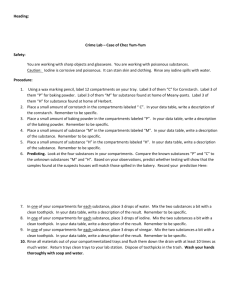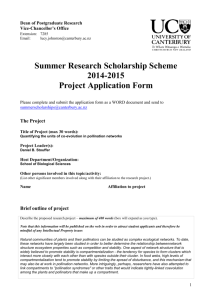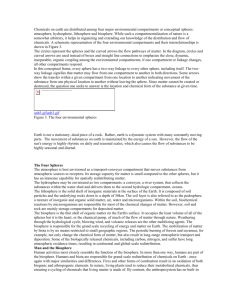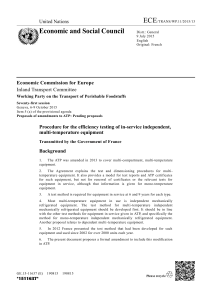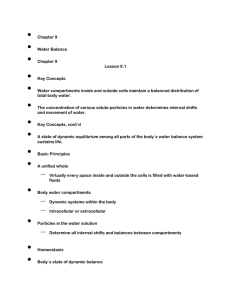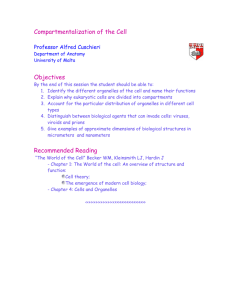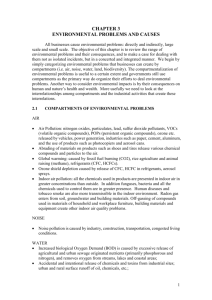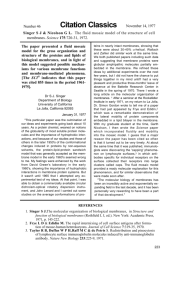Modelling biological compartments in Bio-PEPA
advertisement
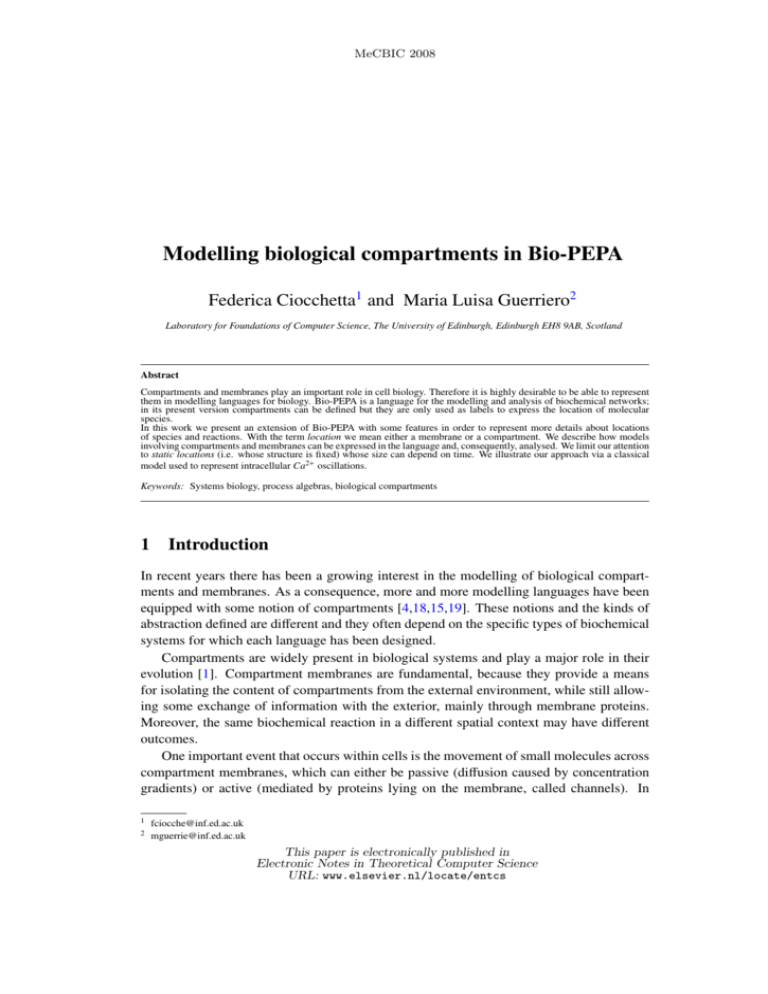
MeCBIC 2008
Modelling biological compartments in Bio-PEPA
Federica Ciocchetta1 and Maria Luisa Guerriero2
Laboratory for Foundations of Computer Science, The University of Edinburgh, Edinburgh EH8 9AB, Scotland
Abstract
Compartments and membranes play an important role in cell biology. Therefore it is highly desirable to be able to represent
them in modelling languages for biology. Bio-PEPA is a language for the modelling and analysis of biochemical networks;
in its present version compartments can be defined but they are only used as labels to express the location of molecular
species.
In this work we present an extension of Bio-PEPA with some features in order to represent more details about locations
of species and reactions. With the term location we mean either a membrane or a compartment. We describe how models
involving compartments and membranes can be expressed in the language and, consequently, analysed. We limit our attention
to static locations (i.e. whose structure is fixed) whose size can depend on time. We illustrate our approach via a classical
model used to represent intracellular Ca2+ oscillations.
Keywords: Systems biology, process algebras, biological compartments
1
Introduction
In recent years there has been a growing interest in the modelling of biological compartments and membranes. As a consequence, more and more modelling languages have been
equipped with some notion of compartments [4,18,15,19]. These notions and the kinds of
abstraction defined are different and they often depend on the specific types of biochemical
systems for which each language has been designed.
Compartments are widely present in biological systems and play a major role in their
evolution [1]. Compartment membranes are fundamental, because they provide a means
for isolating the content of compartments from the external environment, while still allowing some exchange of information with the exterior, mainly through membrane proteins.
Moreover, the same biochemical reaction in a different spatial context may have different
outcomes.
One important event that occurs within cells is the movement of small molecules across
compartment membranes, which can either be passive (diffusion caused by concentration
gradients) or active (mediated by proteins lying on the membrane, called channels). In
1
2
fciocche@inf.ed.ac.uk
mguerrie@inf.ed.ac.uk
This paper is electronically published in
Electronic Notes in Theoretical Computer Science
URL: www.elsevier.nl/locate/entcs
Ciocchetta and Guerriero
addition to allowing molecules to pass across membranes, membrane proteins are also important for the transmission of signals between compartments. Indeed, signalling pathways
involve special membrane-bound proteins, called receptors, which respond to the input of
signalling molecules on one side of the membrane by triggering a cascade of events on the
other side.
Many different molecules reside on membranes. The two main types of membrane proteins are integral and peripheral proteins. Integral proteins are always attached to membranes; they can either span the entire membrane (transmembrane proteins) or be attached
to one side of the membrane (monotopic proteins). They can bind and interact with close
molecules. Peripheral proteins are temporarily attached to membranes: they can bind and
interact with close molecules, and also detach from the membranes. Non-membrane proteins are free to move within the compartment volume: they can bind and interact with
close molecules and, in some cases, pass across membranes.
Bio-PEPA is a language defined recently for the modelling and analysis of biochemical
networks [8,7]. A biochemical network is composed of a set of molecular species, such as
proteins, small molecules, and genes, that interact with each other through some reactions.
The molecular species are located in compartments, such as the nucleus and the cytosol,
or on the membranes which enclose them. Bio-PEPA supports the definition of static compartments as names: compartments are containers for the molecular species and are not
involved in any reactions which change their size or structure. A constant volume (or size)
can be associated with them, and this information is just used in the derivation of the rates
for stochastic simulation [10] from the functional rates given in the Bio-PEPA system. Furthermore, for the derivation of the transition rates and the step size for the transition system
it is implicitly assumed that either all the species are in the same compartment or all the
compartments have the same size. The approach is not appropriate in the general case of
multiple compartments with different sizes, as we will discuss in Sections 3.2 and 3.3.
The aim of this work is to investigate the use of Bio-PEPA for representing multicompartment models and extend the language with notions to express more details about
locations of species and reactions. We introduce the generic notion of locations, which
indicate both membranes and compartments, and we define a compact notation for the representation of species which can be in different compartments. The structure of the system
is described in terms of a hierarchy of locations, that also allows us to define relations
which classify reactions based on their location. The possible kinds of analysis of multicompartment systems are discussed and, in particular, the derivation of the transition rates
for the CTMC is shown.
Here we focus on static locations (i.e. compartments cannot merge, split, or undergo
any structural change) whose size can vary with respect to time. This assumption is motivated by the fact that these kinds of compartment are the ones considered in models present
in databases and in the literature (see for instance models in the BioModels database [13]).
Static locations can be described at different levels of detail. In the models in the literature
or in databases some simplifications are often made. For instance, receptors are assumed to
be in a specific compartment (instead of being on a membrane), volumes and membranes
are not considered explicitly. On the other hand, in the models derived from experimental
data, more details could be given: membranes can be considered explicitly and compartments have different sizes. We keep the language flexible in order to allow the specification
of both levels of detail.
2
Ciocchetta and Guerriero
The structure of the paper is as follows. Section 2 reports a brief description of BioPEPA, while Section 3 is devoted to the definition of our extension. In Section 4 we present
the possible kinds of analysis. As an example, a model for describing intracellular Ca2+
oscillations is presented in Section 5. Section 6 is an overview of the related works, whereas
the last section reports some conclusive remarks.
2
Background: Bio-PEPA
In the following we present a brief description of Bio-PEPA [8,7]. The syntax of Bio-PEPA
is defined as:
C
S ::= (α, κ) op S | S + S | C
P ::= P B
P | S (x)
I
where op = ↓ | ↑ | ⊕ | | .
The component S (species component) abstracts a molecular species and the component P (model component) describes the system and the interactions among components.
The prefix term (α, κ) op S contains information about the role of the species in the reaction
associated with the action type α: κ is the stoichiometry coefficient of the species and the
prefix combinator “op” represents its role in the reaction. Specifically, ↓ indicates a reactant, ↑ a product, ⊕ an activator, an inhibitor, and a generic modifier. The operator “+”
expresses a choice between possible actions and the constant C is defined by an equation
def
C = S . The parameter x ∈ R+ in S (x) represents the (current) concentration. Finally, the
C
Q denotes the cooperation between components: the set I determines those
process P B
I
activities on which the operands are forced to synchronize. In Bio-PEPA, reaction rates are
not expressed in the syntax of components but are defined as functional rates associated
with actions, which allow us to express any kind of kinetic law.
A possible modelling style supported by Bio-PEPA is in terms of concentration levels.
The amount of each molecular species can be discretised into a number of levels, from level
0 (i.e. species not present) to a maximum level N. The level N depends on the maximum
concentration of the species. Each level represents an interval of concentration and the
granularity of the system is expressed in terms of the step size H, i.e. the length of the
concentration interval. The information about the step sizes and the number of levels for
each species is collected in a set N. The view in terms of levels is considered for some
kinds of analysis (see below) and the set N is optional.
The Bio-PEPA system is defined in the following way:
Definition 2.1 A Bio-PEPA system P is a 6-tuple hV, N, K, FR , Components, Pi, where:
V is the set of compartments, N is the set of quantities describing species, K is the set of
parameter definitions, FR is the set of functional rates, Components is the set of definitions
of species components, P is the model component describing the system.
The behaviour of the system is defined in terms of an operational semantics, which
refers to the level-based modelling style. The rules are reported in the Appendix. Two relations are defined. The first one, called capability relation, is indicated by →
− c and is characterised by the label θ. This label is of the form (α, w), where w := [S : op(l, κ)] | w :: w,
with S a species component, l the level and κ the stoichiometry coefficient. The second
relation, called stochastic relation, is →
− s . It has a label γ, defined as γ := (α, rα ), where
+
rα ∈ R is the rate associated with the action. The rates are obtained from the functional
rates, rescaled according to the step size of the reactants. In this definition, rα represents
3
Ciocchetta and Guerriero
the parameter of a negative exponential distribution. The dynamic behaviour of processes
is determined by a race condition: all activities enabled attempt to proceed but only the
fastest succeeds.
A Stochastic Labelled Transition System (SLTS) is defined for a Bio-PEPA system.
From this we can obtain a Continuous Time Markov Chain (CTMC). Both the SLTS and
the CTMC derived from Bio-PEPA are defined in terms of levels of concentration. We call
this Markov chain CTMC with levels.
3
The extension
The main features of this extension are:
•
the notion of compartment is replaced by the more generic notion of location;
•
the definition of a location tree is added to represent the hierarchy of locations;
•
the definition of locations and species are extended in order to contain further details;
•
the possibility to have multiple compartments with different sizes is considered in the
definition of the step size and of the transition rates;
•
in the definition of the Bio-PEPA system we add an (optional) element t, a real nonnegative variable expressing time. It is introduced so that the volume of locations can
explicitly depend on time, and it is considered at the moment of analysis. The Bio-PEPA
system is now defined as hV, N, K, FR , Components, P, ti.
3.1
Locations
Locations are represented by names. With respect to the definition of compartments given
in [8], they are enriched with additional information allowing the modeller to express their
position with respect to the other locations of the system and their kind (i.e. compartment
or membrane). Locations representing membranes are optional: if their role is not relevant, they can be omitted; otherwise, they should be included and their volumes should be
specified. Though we consider membranes to be three-dimensional compartments, it can
be useful to distinguish them from membrane-bounded compartments.
The structure of the biological system is modelled as a static hierarchy, represented as
a tree whose nodes represent locations (compartments and membranes); each node has one
child for each of their sub-locations. The location tree (LT) allows us to keep track of the
relative positions of locations and must be associated with the location definition.
The locations are defined as follows.
Definition 3.1 Each location is described by “L : s unit, kind”, where L is the (unique)
location name, “s” expresses the size and can be either a positive real number or a more
complex mathematical expression depending on time t; the (optional) “unit” denotes the
unit of measure associated with the location size, and “kind” ∈ {M, C} expresses if it is a
membrane or a compartment, respectively. The set of locations is denoted by L.
In the following, we use the functions name and kind, that return the name and the
kind of a given location, respectively. If no compartment is explicitly modelled, a default
location with volume 1 and a location tree with a single node are implicitly defined.
4
Ciocchetta and Guerriero
(a) Compartments hierarchy
(b) LT
(c) LT without
membranes
Fig. 1. Location tree with explicit (b) and implicit (c) membranes for the hierarchy shown in (a) (membrane names are
denoted by lower case characters for the sake of readability).
Example 3.2 The compartment hierarchy represented in Figure 1 (a) can be modelled in
Bio-PEPA by the following list of locations:
L=[
S : volS , C;
A : volA , C;
B : volB , C;
C : volC , C;
D : volD , C;
e : vole , M;
f : vol f , M;
g : volg , M;
h : volh , M;
i : voli , M
] .
The location tree associated with this compartment hierarchy is represented in Figure 1 (b), while Figure 1 (c) refers to the same model with no explicit definition of membranes.
3.2
Species
The definition of species components contains some details about their localisation. We
define the location of the species considering the element species location:
species location ::= L | L1 /L2
where L, L1 , L2 ∈ L and kind(L1 ) , kind(L2 ). This definition allows us to specify if a
species is inside a compartment (species location = L, with kind(L) = C), is across a
membrane, such as transmembrane proteins (species location = L, with kind(L) = M) or
it is on the border between a compartment and an adjacent membrane (species location =
L1 /L2 , with kind(L1 ) = C and kind(L2 ) = M).
In order to make the location of species explicit, the location name is added to each
species component with the notation S @L, indicating that the species represented by the
process S is in the location L. Given the locations L1 , L2 , the components S @L1 and S @L2
represent the species S in the two locations. By using this approach, reactions involving
species located in different compartments can be modelled analogously to standard reactions. A transport of a molecule S from L1 to L2 , for instance, is simply a reaction in which
S @L1 is a reactant and S @L2 is a product.
Representing the same molecule in different compartments as different species components seems a reasonable choice from a biological point of view, since the same molecule
is generally involved in different reactions according to the compartment in which it is
located. In order to avoid the possible duplication of actions in the model (e.g. analogous reactions involving the same molecules occurring in different compartments have to
be duplicated for each species), we propose a notation to represent a species in multiple
5
Ciocchetta and Guerriero
compartments in a compact way. The mapping into the syntax we have just introduced is
straightforward and is just sketched.
Given a species S which can be in L1 , . . . , Ln , one single component S is defined. A
reaction α1 occurring only in Li is defined as (α1 , κ) op S @Li , while α2 occurring in all
locations L1 , . . . , Ln is defined as (α2 , κ) op S . A transport reaction between Li and L j is
represented as (α [Li t op L j ], κ)↓S , where t op = → | ↔. The operator → represents
uni-directional transport, while ↔ is bi-directional. Notice that symport (resp. antiport)
reactions are simply described by synchronizing actions in the species definition of the
involved molecules with the same action type α and the same label [Li t op L j ] (resp. the
inverse label [L j t op Li ]). Channels are modelled as standard activators.
Each species definition S in this notation is simply a shortcut for a set of definitions
S @L1 , . . . , S @Ln , each of which contains only those actions which can occur in the respective location. A reaction α which can occur in different compartments is duplicated (and
a suffix α@Li is added to distinguish them). Each transport reaction (α[Li →L j ], κ)↓S is
duplicated into two synchronizing actions (α, κ)↓S @Li and (α, κ)↑S @L j ; for bi-directional
transport two pairs of actions are defined, (α f , κ)↓S @Li , (α f , κ)↑S @L j and (αb , κ)↓S @L j ,
(αb , κ)↑S @Li ).
In the example described in Section 5 we use this short notation.
3.2.1 Levels and step sizes
Bio-PEPA supports the modelling style in terms of discrete levels of concentration of
species: each component represents a molecular species and it is parametric in terms of
concentration levels. The information about the step size and the number of levels is collected in the set N. This set contains for each species the element C : H, N, unit, where C
is the species component name, H ∈ R+ is the step size, N ∈ N is the maximum level and
unit is the optional unit for concentration. This set is optional; in particular the number of
levels and the step sizes are given only if we are interested in the SLTS and the CTMC with
levels.
If we consider multi-compartment models, some constraints need to be imposed on the
step sizes of different species. Indeed, there must be a “balance” between the molecules
consumed (reactants) and the ones created (products). Specifically, we have that:
(i) all the species in the same location have the same step size.
(ii) The step size for the species in a location depends on the size of the location itself.
Given any two locations with sizes si and s j and step sizes Hi and H j , the following
relation holds (assuming concentrations are given in mol/l):
Hi · si · NA = H j · s j · NA
where NA is the Avogadro number 3 . From this we obtain that H j = Hi ·(si /s j ). Hence,
given the step size of a location, we derive the step size for all the other locations.
(iii) If a species is on the border between a compartment and a membrane (i.e. the location
for the species is of kind L1 /L2 ), we calculate the step size in terms of the size of the
compartment.
The Avogadro number is the number of molecules in one mole. The current best estimate of this number is NA =
6.02214179 · 1023 mol−1 .
3
6
Ciocchetta and Guerriero
3.3
Semantics
Bio-PEPA is given an operational semantics in terms of concentration levels. The same
approach is used in this extension. Two main changes are required:
•
the transition rates for the SLTS must take into account the location of the species;
•
the information about the location is added to the transition labels, and is used to record
the location of the species involved in the reaction (using the capability relation) and to
derive the location of the reaction itself (using the stochastic relation).
In this context we limit our attention to compartments with fixed size. Indeed, the
possibility to consider compartments whose size changes with respect to time is considered
in the other kinds of analysis, as discussed in Section 4.
3.3.1 Capability relation
The label θ of the capability relation is defined as (α, w), where w now contains further
details concerning the location:
w ::= [S : op(l, κ, species location)] | w :: w
where S ∈ C, l is the level, κ is the stoichiometry coefficient and species location is the
location of S . All the labels in the rules are modified according to this new definition.
3.3.2 Stochastic relation
The label γ of the stochastic relation is redefined as (α, r, reaction location), where α is the
action type, r is the rate and reaction location expresses the location where the reaction
associated with α occurs.
The definition of reaction location is derived from the list w of the capability relation.
The following sets of location names are defined:
•
LR ::= {Li ∈ L | (S : op(κ, l, Li )) ∈ w ∧ op = ↓}
•
LP ::= {Li ∈ L | (S : op(κ, l, Li )) ∈ w ∧ op = ↑}
•
L M ::= {Li ∈ L | (S : op(κ, l, Li )) ∈ w ∧ op ∈ {⊕, , }}
•
LRM ::= LR ∪ L M and LPM ::= LP ∪ L M .
If LRM = LPM = {L} then reaction location ::= L else reaction location ::= {Li ∈
LRM }=⇒{L j ∈ LPM }.
If all the reagents of a given reaction are in a single location then the reaction occurs in that location. Otherwise, if reagents are not in the same location, the notation
{Li ∈ LRM }=⇒{L j ∈ LPM } allows us to collect the information about the location of the reactants/modifiers (on the left) and about the product/modifers (on the right). For instance,
if we have that the location of a reaction is {L1 }=⇒{L2 }, we can deduce that the reaction is
a transport reaction between the locations L1 and L2 .
3.3.3 Definition of the SLTS/CTMC transition rates
The transition rates for the SLTS and the CTMC associated with a Bio-PEPA model are
derived from the functional rates. Each functional rate corresponds to a kinetic law and is
expressed as the reaction rate equation (RRE) for the associated reaction. When multiple
7
Ciocchetta and Guerriero
locations with different sizes are present, the RREs are given in terms of molecules or moles
instead of the usual concentrations (see [12] for a discussion about this). Indeed the use of
RREs in terms of concentration in the case of multiple locations is incorrect, since the same
(variation of) concentration in two different locations corresponds to different amounts of
species. In order to make the definition of functional rates homogeneous for all the models,
we always consider them expressed in moles 4 .
In the following we show how to derive the transition rates for the SLTS for a BioPEPA model with explicit locations. As the SLTS for Bio-PEPA refers to concentration
levels, the transition rates must take the discretisation into account. The transition rates are
defined as (∆t)−1 , where ∆t is the time to have a variation of one or more levels (according
to the stoichiometric values) for both the reactants (negative variation) and the products
(positive variation). This ∆t is estimated from the discretisation of the RRE (in moles) for
the species by considering the Taylor approximation. We distinguish four cases, and we
must pay particular attention to the case of reactants/products in different compartments.
(i) All reactants/products in the same compartment. This case is described in detail in [7].
Let f be the kinetic law (in concentration) associated with a reaction and let y be a
variable describing one product of the reaction with stoichiometric coefficient equal
to 1. The rate equation for that species with respect to the given reaction is dy/dt · s =
f ( x̄) · s, where x̄ is the set (or a subset) of the reactants/modifiers of the reaction and s
is the size of the location 5 . We can apply the Taylor expansion up to the second term
and we obtain:
yn+1 · s ≈ yn · s + f ( x̄n ) · s · (tn+1 − tn ) .
Now we can fix yn+1 − yn = H and then derive the respective time interval
f ( x̄n )
∆t = tn+1 − tn as ∆t = f (H·s
x̄n )·s . From this we obtain the transition rate H . A similar
approach is considered when stoichiometry is different from one (see [7] for details).
(ii) Reactants/products in different compartments but with the same size. This is dealt with
as the previous case as the step size is equal for all the species.
(iii) Reactants in a compartment and products in other compartments, with different sizes.
To illustrate our approach we consider a transport reaction A@L1 → A@L2 , where
L1 and L2 are two locations for the species A, with sizes s1 and s2 respectively. The
kinetic law of the reaction is f . Given the concentrations xA1 and xA2 for the species
A in the two locations, we have the following equations:
−
d(xA1 · s1 ) d(xA2 · s2 )
=
= f ( x̄) · s1 .
dt
dt
The transition rate is calculated as before as:
f ( x̄n ) · s1
H1 · s1
where H1 is the step size for the species A in the location L1 . We can simplify the
expression and obtain the usual expression for the rate: fH( x̄)
. This rate seems to depend
1
4 When the kinetic law f is expressed in terms of concentration, the associated functional rate is defined as f multiplied by
the volume s.
5 In the case of one compartment the kinetic law f is expressed in concentration. In Bio-PEPA the functional rate is
expressed in moles, so it is f · s. Here we consider the RRE for y in moles.
8
Ciocchetta and Guerriero
on the location, but if we derive the rate from the rate equation for A in the location
1
L2 , we obtain fH( x̄)·s
, which is the same rate as before, since H1 · s1 = H2 · s2 .
2 ·s2
Note that sometimes the volume size can be kept implicit in the kinetic law, therefore, in the derivation of the rate the parameter s appears explicitly.
(iv) Reactants and products in different compartments with different sizes. The kinetic law
of a reaction whose reactants are in different compartments is generally complex and
depends on the volumes of the compartments where reactants are. We assume that the
modeller is able to define the kinetic law to describe this situation by considering some
hypothesized information about the physical system (see the SBML specification for
further discussion [12]). Under this assumption, we can use the approach proposed
above and the transition rate is obtained by dividing the kinetic law by H · s.
4
Analysis
Bio-PEPA models can be seen as intermediate formal representations of biochemical models from which different kinds of analysis can be performed [8,7]. Mappings from BioPEPA to ODEs, CTMC with levels, stochastic simulation, and PRISM have been defined.
The same approach is considered in this extension.
The analysis of models with explicit locations is generally complex and some strong
assumptions are necessarily made. One of these assumptions, needed for all the kinds of
analysis considered here, is that the content of all locations is well-mixed. Some complications can arise if reactants and products are in different locations (with possibly different
sizes). Two common reactions of this kind are the transport of a species from one compartment to another, and the binding of a ligand in a compartment to a receptor on an adjacent
membrane. Concerning the transport, this generally occurs by means of complex mechanisms such as diffusion; also, the assumption of well-mixed compartments is not always
appropriate for ligand-receptor bindings. Some simplifications and abstractions are often
made in order to make the modelling feasible. Diffusion reactions are abstracted as standard
reactions and modelled with ordinary differential equations, and it is assumed that all the
reactants of a reaction are in the same well-mixed compartment. Furthermore, sometimes
it is assumed that all the locations have the same size.
In the following we briefly discuss the mapping from Bio-PEPA with compartments to
various kinds of analysis and the required assumptions.
Mapping to CTMC with levels. This mapping is as in Bio-PEPA (for details see [7]). In
this context we limit our attention to compartments with fixed size. Indeed the explicit
use of time can be problematic for this approach. The states of the CTMC derived from
Bio-PEPA are defined in terms of the species levels and the transition rates are the ones
reported in the previous section. Given the CTMC with levels, we can perform different
kinds of analysis, for instance model-checking with the PRISM tool [17].
Mapping to stochastic simulation. The mapping is based on two main aspects: the definition of the state of the system in terms of numbers of molecules and the derivation
of the stochastic (basal) rates used in the simulation algorithm. There are some relations between the deterministic kinetic constants (used in RREs) and the stochastic
ones. These relations have been defined in [10] and applied in the context of Bio-PEPA
in [7]. Broadly speaking for monomolecular reactions these two rates coincide, whereas
9
Ciocchetta and Guerriero
in higher-order reactions the stochastic rates must be rescaled according to the volume
where the reactants are. This is straightforward when only one compartment is considered or all the reactants are in the same compartment. However it is not obvious how to
define the stochastic rates when a reaction has reactants in different compartments.
We can distinguish the following situations.
(i) One single well-mixed location. The number of molecules are derived from the
concentrations and the rates are derived from the functional rates by simple calculations (see [7] for details). This approach is valid even if the compartment volumes
can change over time: we can consider the extension of Gillespie’s algorithm given
in [14].
(ii) Multiple well-mixed locations, with no interactions between different locations (i.e.
locations are isolated from each other). We can apply the same approach of (i) to
each location.
(iii) Multiple well-mixed locations, with reactions that can involve species in different
locations but all the reactants are in the same location. Under the assumption that
the system as a whole is well-mixed, the derivation of the stochastic rates is the usual
one, and a stochastic simulation algorithm can be applied.
(iv) Multiple well-mixed locations, with reactions that can involve species in different
locations and reactants that can be in different locations. Here, in addition to the assumption of a well-mixed system we have the further complication of the derivation
of the appropriate stochastic rates. This remains an open question and more investigations are necessary. In the following we assume that the modeller is able to give
these rates.
Mapping to ODEs. The mapping into ODEs is straightforward and identical to Bio-PEPA
(for details see [7]). The mapping is based on the derivation of the stoichiometric matrix
from the Bio-PEPA system, the definition of the species variables (representing concentrations or moles) and on the definition of a kinetic vector containing the kinetic laws.
We consider two cases:
(i) One compartment or multiple compartments with the same size. The variables express the species concentrations and the kinetics is obtained dividing the functional
rate by the volume. These are the standard kinetic laws.
(ii) Multiple compartments with different sizes. The variables express moles and we use
the kinetic laws as expressed in the Bio-PEPA model.
Locations with size depending on time are allowed. In this situation we need to add
some reaction rate equations for location sizes.
5
A model for intracellular calcium oscillations
Intracellular Ca2+ oscillations are observed in a large variety of cell types and play an important role in the control of many cellular processes. There are various models in the
literature that represent simple periodic oscillations for Ca2+ . In addition to these oscillations some experiments show complex periodic behaviour resembling bursting, in which
phases of high frequency oscillations are separated by phases of quiescence, in a pattern
that occurs at regular intervals. Such complex oscillating behaviour can be due to different
factors, such as, for instance, the presence of a feedback loop where the release of Ca2+
directly inhibits a Ca2+ channel (through the IP3 receptor). Several models investigating
10
Ciocchetta and Guerriero
EXTRACELLULAR
Ca
2r
CYTOSOL
11
00
000000 Ca
111111
000000
111111
000000
111111
1f
000000
111111
000000
111111
000000
111111
000000
111111
000000
111111
000000
111111
000000
111111
000000
111111
000000
111111
000000
111111
000000
111111
000000
111111
1b
000000
111111
000000
111111
000000
111111
000000
111111
000000
111111
000000
111111
000000
111111
000000
111111
000000
111111
2b
00
IP3 receptor 11
11
00
11
00
channel
11
00
3
11
00
11
00
11
00
11
00
Ca
SR
Fig. 2. Schema of the basic model for intracellular calcium oscillation (CICR model).
these behaviours have been presented in [3].
Figure 2 describes the basic oscillating model, referred to as CICR (Ca2+ -induced Ca2+
release). Compartments and transport of molecules among them play a major role in this
model. Three main species are considered: extracellular Ca2+ , cytosolic Ca2+ , and Ca2+
in the sarcoplasmic reticulum (SR). The concentration of cytosolic Ca2+ changes due to
the influx of extracellular Ca2+ (reaction 1f ), the passive efflux of Ca2+ from the cytosol
to the extracellular medium (reaction 1b ) and from the SR into the cytosol (reaction 3).
Moreover, Ca2+ is pumped into (reaction 2f ) and released from (reaction 2b ) the SR. The
concentration of extracellular Ca2+ is considered constant.
One possibility to explain the presence of complex oscillations is to take into account
the inhibition of the IP3 receptor channel activity. This channel is both activated and inhibited by cytosolic Ca2+ . In particular, it is assumed that the IP3 receptor has two types of
Ca2+ binding sites at the cytosolic side of the channel, one for positive and one for negative
regulation. The channel can only transport Ca2+ if it is in the active state. In addition to the
reactions shown in Figure 2 we consider the activation and inhibition of the IP3 receptor.
We indicate these two reactions as 4f and 4b and we use the names R Ac and R In to refer
to the two states of the receptor.
In the following we present the specification of the model in Bio-PEPA, in order to
illustrate how locations and reactions involving multiple compartments can be described
in our language. In the model proposed in [3] compartments are assumed to have all the
same size, and the parameters and concentrations are defined accordingly. This assumption
is generally introduced to simplify the model and the analysis, and is particularly useful when precise data on compartment volumes are not available. Here we consider the
same assumption in the definition of the Bio-PEPA system, in order to obtain a comparable
model. However, since Bio-PEPA supports multiple compartments with different sizes, a
more accurate representation of the biochemical system could be obtained if quantitative
information about compartment volumes are available.
5.1
Bio-PEPA system
Definition of compartments:
V = [Ext : 1 µl, C; Cyt : 1 µl, C; S R : 1 µl, C]
11
Ciocchetta and Guerriero
Definition of functional rates and constants:
f1f = (v0 + v1 · β) · Ext;
Ca@Cyt2
f2f = V M2 · K 2 +Ca@Cyt2 · Cyt;
a 2 4
·Ca@Cyt ·R Ac@Cyt
f2b = β · d 1+( a ·Ca@Cyt4 ) · V M3 ·
d
f1b = (k · Ca@Cyt) · Cyt;
f3 = (k f · Ca@S R) · S R;
Ca@S R2
2
2
KCa@S
R +Ca@S R
· S R;
f4f = (kd · Ca@Cyt4 · R Ac@Cyt) · S R;
f4b = (kr · R In@Cyt) · Cyt
Note that the functional rates are expressed in moles (all the kinetic laws are multiplied
by a location: here Cyt, S R, Ext refer to the size of the associated location). The kinetic
constants are as defined in [3]:
v0 = 1 (µmol/l).min−1 ;
v1 = 1 (µmol/l).min−1 ;
β = 0.5;
k = 10 min−1 ;
k f = 1 min−1 ;
V M2 = 6.5 (µmol/l).min−1 ;
K2 = 0.1 µmol/l;
V M3 = 50 (µmol/l).min−1 ;
KCa@S R = 0.2 µmol/l;
kd = 5000 (µmol/l)−4 .min−1 ;
kr = 5 min−1 ;
a = 40000 min−1 .(µmol/l)−4 ; d = 100 min−1
Definition of species components:
def
=
Ca
(α1f , 1)↑Ca@Cyt + (α1b , 1)↓Ca@Cyt +
(α1f , 1) Ca@Ext + (α1b , 1) Ca@Ext +
(α2 [Cyt↔S R], 1)↓Ca + (α3 [S R→Cyt], 1)↓Ca + (α4f , 1) ⊕ Ca@Cyt;
R Ac
R In
def
=
(α2 , 1) ⊕ R Ac + (α4f , 1)↓R Ac + (α4b , 1)↑R Ac;
def
(α4f , 1)↑R In + (α4b , 1)↓R In
=
Definition of the model component:
(((Ca@Ext(0.1) B
C Ca@Cyt(0.5)) BC Ca@SR(1.9)) BC R Ac@Cyt(0.1)) BC R In@Cyt(0.9)
5.1.1 Analysis
The Bio-PEPA model can be analysed by using different approaches; in the following we
show some analysis results obtained from two of them. First we consider simulation by
ODEs in order to compare our results with the ones in the literature. Figure 3 reports the
temporal evolution of Ca2+ in the sarcoplasmic reticulum and Ca2+ in the cytosol. Both
species show simple periodic oscillations. These results are in agreement with the original
paper [3].
Secondly, we consider the PRISM model-checker [17] in order to get a further confirmation of the oscillatory behaviour of the system. The information about step sizes must be
provided. Here, we use H = 0.01 for all the species, since the volumes of the compartments
are the same. For our purposes we verify the CSL formula
P≤0 [> U (((S = i) ∧ P≤0 [> U (S , i)]) ∨ ((S , i) ∧ P≤0 [> U (S = i)]))]
over all the values i the species S can assume (where S ∈ {Ca@S R, Ca@Cyt}). This
12
Ciocchetta and Guerriero
2.5
2
1.5
1
0.5
0
0
1
2
3
Ca @ Cyt
4
5
Ca @ SR
Fig. 3. ODE simulation
formula (see [2]) verifies that the species Ca@S R and Ca@Cyt oscillate permanently: this
confirms the evolution exhibited by the ODEs simulation, and also guarantees that such
behaviour is not limited to the chosen time bound, but is perpetual.
6
Related works
Several languages have been proposed to model biological compartments and membranes [18,4,16,19,15]. All of them have some differences in the considered notion of
compartment, in the kinds of operations allowed, and in the underlying assumptions.
The BioAmbients calculus [18] was the first process calculus for modelling biological
systems with an explicit notion of compartments. A system is represented as a hierarchy
of nested ambients, which represent the boundaries of compartments containing communicating processes whose actions specify the evolution of the system. Operations involving
compartments, complex formation and transport of small molecules across compartments
can be easily represented in BioAmbients.
In Brane calculi [4], membranes are not just containers, but active entities that are responsible for coordinating specific activities. A system is represented as a set of nested
membranes, and a membrane is represented as a set of actions. Operations such as the
transport of small molecules across membranes can be easily represented; moreover, membranes can move, merge, split, enter into and exit from other membranes.
In Beta-binders [16] systems are modelled as a composition of boxes representing biological entities. Although the nesting of boxes is forbidden, the typing for sites provides
a virtual form of nesting, which makes the representation of hierarchies of compartments
possible. Explicit static compartments and transport of objects across them have been added
to Beta-binders in [11]. The possibility to deal with compartments whose volume depends
on time is considered in BlenX [9], a language based on Beta-binders.
The stochastic π-calculus has also been equipped with notions of locations in some of
its variants. In particular, we mention the Sπ@ calculus [19], an extension of the stochastic
π-calculus in which compartments are explicitly added to the syntax. This language has
been primarily designed to be a core language for encoding different compartment-based
formalisms, and it handles varying volumes and dynamical compartments by defining the
13
Ciocchetta and Guerriero
compartment volume as the sum of the volumes occupied by all the molecules it contains.
Finally, membrane systems (also called P systems) [15,6] are computational models
based upon the notion of membrane structure, and on the observation that complex biological systems are composed by independent computing processes separated by and communicating through membranes. Membranes delimit regions and comprise objects and evolution
rules. A computation is obtained starting from an initial configuration of membranes and
objects, and repeatedly applying evolution rules. In [5] membrane proteins are explicitly
represented and used in mediating transport of proteins across membranes.
All these languages differ from Bio-PEPA in various aspects. Most of them are based
on different levels of abstraction (for instance Beta-binders, BioAmbients, Brane calculi)
or focus on dynamical compartments (for instance BioAmbients) or handle volumes in a
different way (for instance Sπ@). Bio-PEPA captures the level of abstraction of biochemical networks and therefore some details that can be represented in other languages are not
of interest.
Differently from Brane calculi, which are limited to membrane operations (and therefore are more precise in their representation), the focus on Bio-PEPA is on the interaction of
molecular species and on their biochemical modifications: hence, it allows a more intuitive
modelling of molecular reactions that are not directly related to membranes. BioAmbients
offers an intuitive modelling of hierarchies of compartments, but it does not provide an
explicit way to model membrane proteins, which makes the modelling of interactions between membrane proteins and internal proteins not easy. Moreover, reactions such as the
movement of small molecules across cellular membranes, require molecules to be enclosed
within an ambient.
Membrane systems allow an intuitive representation of biochemical reactions and transports across membranes and provide an abstract view of compartments, though they lack
some details regarding species and reactions. For instance (analogously to Brane calculi,
BioAmbients and Beta-binders), quantitative information regarding compartment sizes are
not considered and, therefore, volumes are implicitly taken into account in reaction rates. In
Sπ@, instead, compartment sizes are explicitly considered but, differently from Bio-PEPA,
they are obtained as the sum of the sizes of all the contained molecular species (assuming
the size of each molecular species is known, and that changes in volume of compartments
are directly related to changes in their contents).
Concluding, Bio-PEPA is particularly appropriate for describing systems at a high level
of abstraction, similarly to models usually present in databases and in the literature. For
such abstraction, compartments are essentially containers for molecular species: they allow some limited interaction between molecules lying in different compartments, but the
main evolution is given by interactions of molecular species within compartments. In these
cases Bio-PEPA offers a direct, formal representation of the system, allowing an intuitive
representation of both intra-compartment and inter-compartment reactions.
Another main feature of Bio-PEPA is that it supports various kinds of analysis. This
is very important as these analyses can help us to understand different related features of
biochemical systems. Note that, among the various techniques, there is the possibility to
consider model-checking. This is particularly helpful in order to understand the behaviour
of the system, as it allows us to answer quantitative temporal queries by performing an
exhaustive exploration of all the possible paths through the system. By means of modelchecking, we can detect possible errors in the model and verify some relevant properties
14
Ciocchetta and Guerriero
of the system, not easily observable from simulation results. The possibility of different
analyses is also supported by membrane systems, whereas most of the other languages
listed above essentially limit the possible analyses to stochastic simulation.
7
Discussion and conclusions
Compartments and membranes play a key role in biochemical systems and, consequently,
it is essential for a modelling language to allow a correct and intuitive representation of
those notions.
We have enriched the Bio-PEPA process algebra with specific features useful to model
biological compartments. A notion of location has been introduced and, in addition to
three-dimensional compartments, their enclosing membranes can also be explicitly defined.
Transports and other reactions involving molecular species in multiple compartments can
be easily modelled in this extension.
Different kinds of analysis can be performed (based on ODEs, CTMCs, and stochastic
simulation). Several assumptions are required in order to apply these analyses to multicompartment models (e.g. most analysis methods assume systems to be a well-stirred mixture of molecules). Though these assumptions are generally very strong, such methods
have been shown to provide good approximations of the behaviour of multi-compartment
systems. In this extension of Bio-PEPA we have relied on these standard assumptions and
we have shown how to correctly derive models for these kinds of analysis from Bio-PEPA
models with multiple compartments.
In this work we have focused on static locations (i.e. whose structure does not change,
but whose size can change over time); the management of dynamical locations (i.e. which
can split, merge, etc.) would require even stronger assumptions and would make the language much more heavy. Moreover, currently, neither the existing mathematical models
nor the experimental data provide such a level of detail.
Acknowledgement
The authors thank Jane Hillston, Stephen Gilmore, Cristian Versari and Laurence Loewe
for their helpful comments. Federica Ciocchetta is supported by the U.K. Engineering
and Physical Sciences Research Council (EPSRC) research grant EP/C543696/1 “Process
Algebra Approaches to Collective Dynamics”. Maria Luisa Guerriero is supported by the
EPSRC grant EP/E031439/1 “Stochastic Process Algebra for Biochemical Signalling Pathway Analysis”.
References
[1] B. Alberts, A. Johnson, J. Lewis, M. Raff, K. Roberts, and P. Walter. Molecular biology of the cell (IV ed.). Garland
Science, 2002.
[2] P. Ballarini, R. Mardare, and I. Mura. Analysing Biochemical Oscillation through Probabilistic Model Checking. In
Proc. of FBTC 2008, To appear in ENTCS, 2008.
[3] J.A.M. Borghans, G. Dupont, and A. Goldbeter. Complex intracellular calcium oscillations: A theoretical exploration
of possible mechanisms. Biophysical Chemistry, 66(1):25–41, 1997.
[4] L. Cardelli. Brane Calculi - Interactions of Biological Membranes. In Proceedings of Computational Methods in
Systems Biology (CMSB’04), volume 3082 of LNCS, pages 257–278, 2005.
15
Ciocchetta and Guerriero
[5] M. Cavaliere and S. Sedwards. Modelling Cellular Processes Using Membrane Systems with Peripheral and Integral
Proteins. In Proc. of CMSB 2006, volume 4210 of LNCS, pages 108–126, 2006.
[6] G. Ciobanu, M.J. Pérez-Jiménez, and G. Păun, editors. Applications of Membrane Computing. Natural Computing
Series. Springer, 2006.
[7] F. Ciocchetta and J. Hillston. Bio-PEPA: a framework for the modelling and analysis of biological systems, 2008.
School of Informatics University of Edinburgh Technical Report EDI-INF-RR-1231.
[8] F. Ciocchetta and J. Hillston. Bio-PEPA: an extension of the process algebra PEPA for biochemical networks. In Proc.
of FBTC 2007, volume 194 of ENTCS, pages 103–117, 2008.
[9] L. Demattè, A. Romanel, and C. Priami. The BlenX Language: A Tutorial. In SFM-Bio 2008, volume 5016 of LNCS,
pages 313–365, 2008.
[10] D.T. Gillespie. Exact stochastic simulation of coupled chemical reactions.
81(25):2340–2361, 1977.
Journal of Physical Chemistry,
[11] M.L. Guerriero, C. Priami, and A. Romanel. Modeling Static Biological Compartments with Beta-binders. In Proc. of
Algebraic Biology (AB 2007), volume 4545 of LNCS, pages 247–261, 2007.
[12] M. Hucka, A. Finney, S. Hoops, S. Keating, and N. Le Novére. System Biology Markup Language (SBML) Level 2:
Structure and Facilities for Model Definitions. Available at http://sbml.org/index.php/Documents/Specifications.
[13] N. Le Novére, B. Bornstein, A. Broicher, M. Courtot, M. Donizelli, H. Dharuri, L. Li, H. Sauro, M. Schilstra, B. Shapiro,
J.L. Snoep, and M. Hucka. BioModels Database: a free, centralized database of curated, published, quantitative kinetic
models of biochemical and cellular systems. Nucleic Acids Research, 34(Database issue):D689–D691, 2006.
[14] T. Lu, D. Volfson, L. Tsimring, and J. Hasty. Cellular growth and division in the Gillespie algorithm. Systems Biology,
1(1):121–128, 2004.
[15] G. Păun. Membrane Computing: An Introduction. Springer-Verlag, 2002.
[16] C. Priami and P. Quaglia. Beta binders for biological interactions. In Proceedings of Computational Methods in Systems
Biology (CMSB’04), volume 3082 of LNCS, pages 20–33. Springer, 2005.
[17] PRISM web site. http://www.prismmodelchecker.org/.
[18] A. Regev, E.M. Panina, W. Silverman, L. Cardelli, and E.Y. Shapiro. BioAmbients: an Abstraction for Biological
Compartments. Theoretical Computer Science, 325(1):141–167, 2004.
[19] C. Versari and N. Busi. Efficient stochastic simulation of biological systems with multiple variable volumes. In Proc.
of FBTC 2007, volume 194 of ENTCS, 2008.
A
Bio-PEPA semantics
In this Appendix we report the semantics rules for Bio-PEPA. For details see [8,7]. The
semantics of Bio-PEPA refers to the level-based modelling style and is defined in terms of
two relations. The former, called capability relation, is →
− c ⊆ C × Θ × C, where C is the set
of the Bio-PEPA components and Θ is the set of labels θ = (α, w). The capability relation
is defined as the minimum relation satisfying the rules reported in Table A.1.
The stochastic relation is defined in terms of the capability relation. It associates each
action with a rate. The stochastic relation is →
− s ⊆ P̃ × Γ × P̃, where Γ is the set of labels
(α, r), with α the action type and r the rate, and P̃ is the set of well-defined Bio-PEPA
systems. The stochastic relation is defined as the minimal relation satisfying the rule:
(α j ,w)
P−−−−→c P0
Final
(α j ,rα [w,N,K])
hV, N, K, F , Comp, Pi−−−−−−−−−−−→ s hV, N, K, F , Comp, P0 i
The rate rα [w, N, K] is defined as:
rα [w, N, K] =
fα [w, N, K]
H
where H is the step size for the species involved in the reaction and the notation fα [w, N, K]
means that the function fα is evaluated over w, N and K.
16
Ciocchetta and Guerriero
Table A.1
Axioms and rules for Bio-PEPA.
prefixReac
(α,[S :↓(l,κ)])
((α, κ)↓S )(l) −−−−−−−−−→c S (l − κ) κ ≤ l ≤ N
prefixProd
(α,[S :↑(l,κ)])
((α, κ)↑S )(l) −−−−−−−−−→c S (l + κ)
prefixMod
((α, κ) op S )(l) −−−−−−−−−−→c S (l)
0 ≤ l ≤ (N − κ)
(α,[S :op(l,κ)])
with op ∈ {, ⊕, } and 0 < l ≤ N if op = ⊕, 0 ≤ l ≤ N otherwise
(α,w)
S 1 (l) −−−−→c S 10 (l0 )
choice1
(α,w)
(S 1 + S 2 )(l) −−−−→c S 10 (l0 )
(α,w)
S 2 (l) −−−−→c S 20 (l0 )
choice2
(α,w)
(S 1 + S 2 )(l) −−−−→c S 20 (l0 )
(α,S :[op(l,κ)])
constant
S (l) −−−−−−−−−−→c S 0 (l0 )
(α,C:[op(l,κ)])
de f
with C = S
C(l) −−−−−−−−−−→c S 0 (l0 )
(α,w)
coop1
P1 −−−−→c P01
(α,w)
C
C
P1 B
P2 −−−−→c P01 B
P2
I
I
with α < I
(α,w)
P2 −−−−→c P02
coop2
P1
(α,w)
C
B
C
P2 −−−−→c P1 B
P02
I
I
(α,w1 )
coop3
P1 −
−−−−
→c P01
P1
with α < I
(α,w2 )
P2 −−−−−→c P02
(α,w1 ::w2 )
B
C
C
P
P02
−
−−−−−−→c P01 B
2
I
I
17
with α ∈ I
